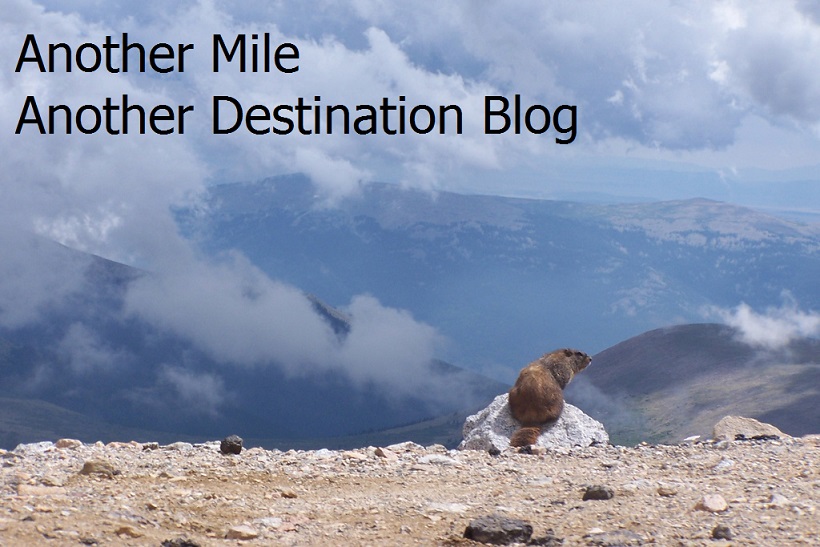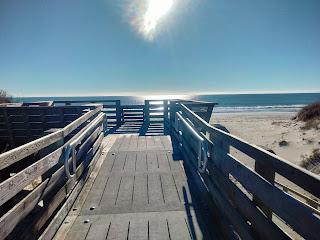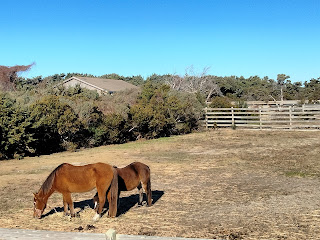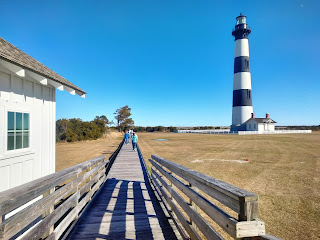“Ah, the smell of salt and sand. There is no elixir on this blessed earth like it.”
Anonymous
How
can you describe the Outer Banks? It is a different world and one of
the most unusual and unique places I’ve ever visited. The narrow
strip of land that forms barrier islands and peninsulas, goes on for
200 miles. At some places it is so narrow, that it is barely 100
yards wide and is very vulnerable to the rise of the sea and coastal
erosion. Other areas are wide enough to have a normal size town.
There are wide expanses of open beachfront so plentiful that there is
much room for everyone and many areas you can find yourself one of
only a few on the beach.
Over
all that stretch of land is starkly beautiful and when you climb up
on the dunes in certain areas, you feel like you are on a different
planet with nothing but rolling sand dunes and sea oats. There are
designated places to cross the dunes – as they do not want the
dunes to be damaged since they are so valuable to preserve this land.
Some of the dunes are as high as 30 feet high. The beach side of
the strip is gorgeous with rolling waves splashing against the sandy
beach. Since it was winter when we were there the beaches were
deserted and so gorgeous.
We came up from Georgia and spent the night on Ocracoke Island. While on Ocracoke Island, we visited the Ocracoke Light House. What a beautiful sight with the blue sky above it. She was built in 1823 and stands 75 feet high. This is the oldest operating lighthouse in North Carolina that is still standing. You can no longer climb to the top of the lighthouse as it needs maintenance done. She is a beautiful sight to see.
We stopped at the Ocracoke Preservation Society very early and it was not open. This is a museum that shows the history of Ocracoke Island and is located near the ferry terminal. Maybe we can make it inside on our next visit.
The
next day, we took the free ferry over to Cape Hatteras. What a great
way to travel. The ferry ride provided lots of beautiful scenery and
wildlife as we rode across Pamlico Sound.
Have
you ever seen the oval stickers with OBX? If you have it refers to
the Outer Banks. The OBX stretches from Ocracoke Island north to the
Virginia border. What drives people to visit the Outer Banks you
ask? Could it be the windswept beaches, historic sites, wild horses,
and pristine maritime forests. I would say yes, and so much more.
As
we drove up the Outer Banks, we stopped at many places. Our first
stop was to see the Cape Hatteras Lighthouse, which is probably the
most recognized lighthouse in the United States. It was built in
1870 and protects one of the most hazardous areas off the Atlantic
Coast, known as “The Graveyard of the Atlantic.” The lighthouse
is located in the middle of Cape Hatteras National Seashore and
stands 210 feet tall. It is the tallest brick lighthouse in the
United States and is just stunning. The lighthouse was being
threatened by beach erosion and it was actually moved 2,900 feet in
23 days in 1999. That was such an amazing engineering feat that was a
perfect success and will keep this lighthouse thriving for many
years. This is one beautiful lighthouse to see. The lighthouse
wasn’t open to climb the day we were there as it was in the middle
of winter.
We
drove further north and stopped at the Pea Island National Wildlife
Refuge where we saw a lot of vehicles pulled over on the side of the
road. People with amazing cameras were stopped on the side of the
road, taking pictures of these beautiful sea birds. Everyone stayed
quiet and tried not to disturb the wildlife. We saw beautiful Snow
geese, migratory waterfowl, shorebirds, wading birds and raptors. It
is a beautiful area with ponds and sand dunes. It was amazing seeing
so much wildlife in a small area. This is a popular stopping place
and a great place for birders or just nature lovers.
After
watching the birds come and go for awhile, we headed to see Bodie
Lighthouse. This is another gorgeous lighthouse to see that was first
lit on October 1st, 1872. The Double Keepers’ Quarters
in front of the 156 foot lighthouse make it very picturesque. To
get to this lighthouse, we turned into the park off Highway 12 and
went down a narrow road with tall pines on either side and freshwater
marshland around it. This road was totally different from any other
road that we saw on the barrier islands. We continued down this road
till we got to the clearing where the gorgeous lighthouse stood.
Once again, we were unable to walk up the lighthouse as it was
closed. Near the lighthouse is a nature trail and boardwalk out to
the marsh where you can observe the wildlife.
We
continued driving up the coast. At times, we were driving through
areas where sand dunes were on either side of us. At other times, we
could see the sound water from the road that appeared to be at the
same level as us. Then there were areas where the winds had swept
the dunes into the road and tractors were on the side of the road
prepared to get the sand off the road and back on the dunes. Sea
Oats adorned the dunes as well as small brush which helps hold them
in place. Then, out of no where, would be a town with stores and
shore homes with balconies providing great views of the coast. There
are quaint villages along the way such as Corolla, Duck, Kitty Hawk,
Nags Head, Buxton, Kill Devil, and Rodanthe.
Further
north, we decided to stop at Jockeys Ridge State Park. It looked
interesting from Highway 12 so we figured it would be a good stop.
We pulled in and parked in this free park and headed up the trail
through an interesting stand of trees. As we continued walking, we
came to a clearing where you could see the many dunes including one
huge one off in the distance. On top of largest dune, they were
giving hang gliding lessons. We watched as a little girl got on and
the instructors ran holding onto the hang glider guiding it as it
flew down the dune. What fun. We also saw many people carrying a
thin sleds to the top of the dunes to sled down. They came down
fast squealing with delight. That was a fun stop.
By
that time, we were hungry and decided to get a bite. We headed to
the Black Pelican in Kitty Hawk for dinner. This is our go to
restaurant in this area as it never disappoints. This building was
built in 1874 and was used as a United States Lifesaving Station at
one time. The food was great plus they had a happy hour special on
their raw oysters. Joe is a big fan and was not disappointed. Our
dinner was great and we left there totally stuffed and happy. It is
a charming restaurant full of rustic décor and items from maritime
history. The cherry on the top was that we had the best waitress
ever, McKenzie, who took very good care of us and was a joy to be
around.
We
had a great time exploring the Outer Banks and we will be back. It
is a great place to loose yourself in the beauty of nature. We love
it here and enjoy it even in the winter.
Till
next time. Bye for now.





















































































































































